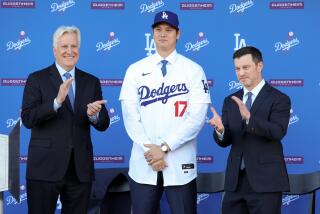Baseball Wants Union Partnership : Major Leagues: Owners are determined to begin an expense-sharing plan with the players that would eliminate salary arbitration and the need for agents.
- Share via
PALM SPRINGS — Formal negotiations on baseball’s new collective bargaining agreement are set to begin next week, with the clubs determined to implement a new economic system and the union almost certain to oppose it.
Barry Rona, executive director and legal counsel to the owners’ Player Relations Committee, drew a hard line Tuesday in anticipation of the union’s objections, saying the clubs won’t be rebuffed.
“I anticipate that the union won’t deal with this unless it has to,” Rona said, adding that it will have to “once it realizes how seriously the owners are committed to this concept and won’t walk away from it.”
Rona will outline what he calls the expense-sharing or partnership proposal for the 26 general managers, currently holding their annual winter meetings here, today.
The owners, however, have already approved it, and Rona predicted that the Major League Players Assn. will find a lot to like in it, once he can move the negotiations past what he described as the “immediate goblins.”
The question is:
How can the union find anything to like with a system that would eliminate salary arbitration and the need for agents--at least for players with zero to six years of service; erase the 20% limit on pay cuts; impose a salary scale for players with six years’ service or less, and provide for a salary cap of sorts?
There is no immediate answer. Don Fehr, executive director of the union, has said he can’t comment until he sees some specific numbers.
The intent, Rona said, is to end an acrimonious relationship, and threats of a strike or lockout, by forming a partnership with the players through a revenue- or expense-sharing adaptation of the National Basketball Assn. system.
Rona outlined the package, leaving out specific numbers that he has yet to provide the union and which, he said, are negotiable.
The key points:
--Owners and players would agree to a specific amount of revenue being reserved for salaries, some allocated to players with zero to six years of service and some guaranteed for players with more.
--Salaries for players with zero to six years of service would be determined by statistical ranking over a two-year period, and the salaries for all players in this category--about 40% of the big league total--would be shared equally by the 26 clubs.
--Players with more than six years of service could be paid any amount a club deems appropriate, but there would be two built-in factors affecting payrolls--a guaranteed minimum and a ceiling of sorts.
If the negotiated minimum were $12 million per club, the figure Rona used as an example, and the club payroll was below that, the club would have to give the players’ association the difference.
If the ceiling or cap were $16 million per club, the figure Rona used as an example, the club could exceed it, but could not sign a free agent until it was again below the $16-million figure.
Rona conceded that with some clubs eliminated from free agency, there would be a loss of mobility but said the overall plan addressed two areas of union concern: The guaranteed revenue eliminated the risk of collusive behavior and the pay-for-performance statistical system guaranteed that younger players wouldn’t be underpaid.
In addition, he said that the NBA partnership has led to joint licensing and drug agreements with the players and an overall improved atmosphere.
It was a plan, he said, born of financial desperation.
Baseball, he pointed out, is coming off a high. There is not that same “give-back” situation or need. A golden time, Rona said, to voluntarily “create a meaningful partnership” that would ensure the owners’ profitability and allow the players to grow with it.
The union, of course, may cite the golden highs of revenue and attendance and question the need for change. It may also question how a statistical table can accurately gauge the differences in leagues or measure intangibles such as heart and team play.
And it is bound to suggest that the owners are only attempting to eliminate two of their top evils: arbitration and agents.
Is an impasse inevitable?
“The concept of a lockout has received a great deal of publicity because of the clauses that have been written into some contracts,” Rona said. “The only thing I have suggested to the owners is that they maintain the option of a lockout at the opening of spring training, depending on the status of negotiations.
“That’s the first time a decision would have to be made, but it’s an option and nothing more. It’s pure nonsense to think anyone wants a work stoppage or would benefit by it.”
Both sides have their lines of credit and emergency funds ready, however.
And management’s commitment to this new structure--its belief that revenue-sharing is imperative if teams in smaller markets are to compete with those in cable-rich larger markets, that the escalation of average salary (from $430,000 in 1988 to $588,000 in 1989) has to be curtailed--almost seems to belie what commissioner Fay Vincent said to the general managers here Monday.
Vincent addressed the question of labor relations and said there was need for improved stability and climate, and reminded the general managers that the pending negotiations represented only an allocation of resources and not a moral determination of right and wrong.
More to Read
Go beyond the scoreboard
Get the latest on L.A.'s teams in the daily Sports Report newsletter.
You may occasionally receive promotional content from the Los Angeles Times.










